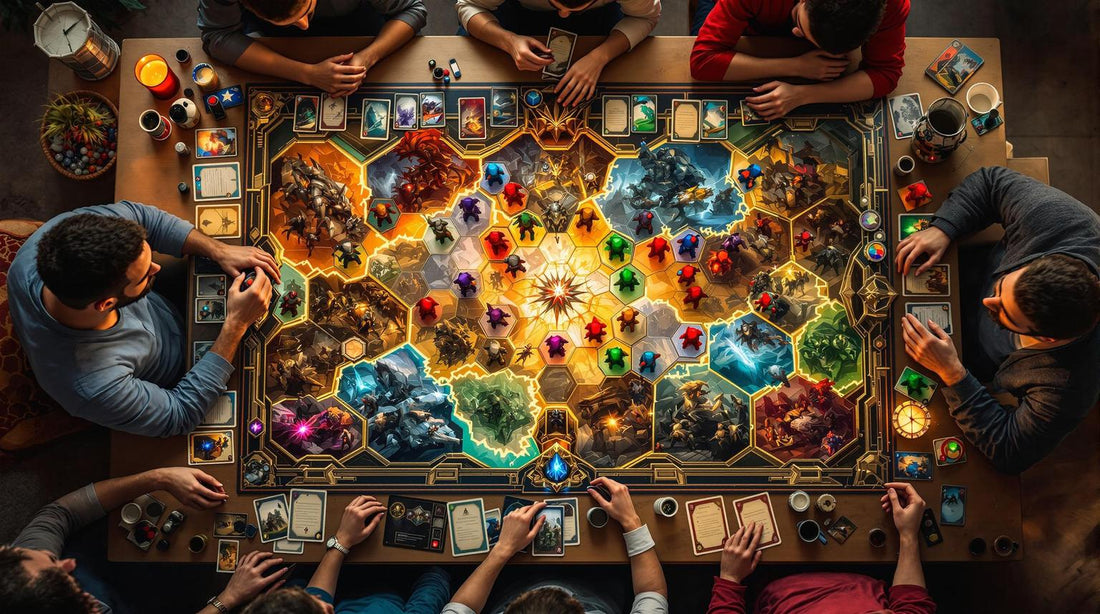Discover the Best Board Games for Every Player

Resource Management in Games: Offense and Defense
Resource management in games is all about making smart decisions with your resources - like units, currency, energy, and time - to balance offense and defense. The key is knowing when to attack, when to defend, and how to adapt to your opponent's moves. Here's what you need to know:
- Offense vs. Defense: Balance resources to apply pressure (offense) or protect assets (defense). Adjust based on threats and opportunities.
- Core Resources: Manage units for combat, currency for upgrades, energy for abilities, and time for pacing.
- Short vs. Long-term Planning: Early game often leans defensive; late game may shift to offense depending on your position and opponents.
- Tactics: Use aggressive strategies like disrupting opponents' economies or defensive strategies to strengthen positions and generate resources.
- Adaptation: Stay flexible. Switch strategies mid-game as conditions change.
Quick Comparison of Resource Strategies
| Strategy Type | Advantages | Disadvantages | Best Used When |
|---|---|---|---|
| Aggressive Expansion | Quick territory gain, early pressure | Risk of overextending | Early-game offensive opportunities |
| Conservative Build | Strong resource base, stable growth | Slower expansion | Facing aggressive opponents |
| Balanced Distribution | Adaptable, steady progress | May lack focus | General gameplay situations |
Mastering resource management means staying one step ahead by allocating your resources wisely, anticipating opponent moves, and adjusting your strategy as the game evolves.
How Do You Balance Resource Management in a Strategy Board Game?
Core Resource Management Elements
Understanding the basics of resource management is just the start. To excel, you need to master the key elements that help balance your offensive and defensive strategies.
Common Game Resources
In most games, players juggle multiple resources at once. Each type plays a distinct role in shaping your strategy:
| Resource Type | Strategic Role | Influence on Gameplay |
|---|---|---|
| Units | Combat strength | Drives offensive moves and defensive stability |
| Currency | Economic flexibility | Funds upgrades and acquires additional assets |
| Energy | Action potential | Powers abilities and special moves |
| Time | Strategic pacing | Affects development speed and reaction times |
Take Civilization VI, for example. Players must carefully manage military units to protect their territory while expanding, all while maintaining a robust economy to fuel growth. These resources are the foundation for making smart, timely decisions.
Making Resource Choices
Winning strategies often come down to prioritizing where resources go. Players should focus on:
- Supporting key objectives: Allocate enough resources to hit your main goals.
- Maintaining a safety net: Always keep reserves to handle unexpected threats.
- Investing in growth: Build resource-generating systems to stay competitive long-term.
These priorities help players juggle immediate needs without losing sight of their overarching strategy.
Short vs. Long-term Planning
Balancing immediate defense with future growth is a constant challenge. Here’s what to consider:
- Game phase: Early on, defensive strategies often take precedence.
- Opponent behavior: Aggressive opponents might force you to invest more in defense.
- Resource levels: A surplus of resources can allow for bolder, long-term plays.
- Strategic position: If you’re in a strong spot, you can afford to focus more on offense.
Mastering these trade-offs ensures you’re prepared for both immediate challenges and future opportunities.
sbb-itb-1ed942f
Attack and Defense Tactics
Deciding how to allocate resources can shape the difference between gaining an early edge or exposing weaknesses later in gameplay.
Attack-focused Methods
Offensive strategies rely on using resources to apply pressure on the opponent while managing your own reserves wisely.
| Strategy | Resource Focus | How It Works |
|---|---|---|
| Early Aggression | Military Units | Deploy forces quickly to disrupt the opponent's economy |
| Economic Disruption | Mixed Forces | Target and hinder the opponent's ability to gather resources |
A strong offense requires balancing aggressive actions with resource conservation. For example, in games like Starcraft, players often use early aggression to throw off their opponent's economy. This forces the opponent to divert resources and adjust their strategy.
Defense-focused Methods
Defensive strategies aim to protect assets and ensure a steady flow of resources. In games such as Magic: The Gathering, players often rely on life-gain abilities and durable creatures to create a stable defense. Core principles include:
- Strengthening key positions to safeguard assets
- Ensuring consistent resource generation for long-term stability
Changing Tactics Mid-game
Sometimes, sticking to one strategy isn't enough. Mid-game adjustments can be crucial when the situation shifts. In games like HeroClix, players might need to switch from an offensive approach to a defensive one in response to unexpected moves by their opponent. To stay ahead, keep an eye on both your own position and your opponent’s actions, reallocating resources as needed.
Resource Distribution Methods
Effective resource management is all about dividing assets wisely between offense and defense. Building on earlier tactics and strategies, this section dives into practical ways to allocate resources during gameplay.
Resource Planning
Start by evaluating the assets you have and their potential uses. The key is to balance essential operations with the ability to adapt to changing situations. While the exact allocation depends on the game's conditions, focus on maintaining core operations while setting aside resources for unexpected needs.
Reading Opponent Moves
Recognizing patterns in your opponent's behavior is crucial for adjusting your strategy. Pay attention to their recurring tactics and predict their next moves. Here's a quick guide:
| Behavior Pattern | What to Watch For | Suggested Resource Allocation |
|---|---|---|
| Early Aggression | Rapid unit production, resource rush | Shift more resources to defense |
| Economic Focus | Heavy resource gathering, fewer units | Keep a balanced allocation |
| Defensive Stance | Defensive structures, slow expansion | Gradually boost offensive resources |
Resource Strategy Comparison
Different approaches to resource management excel in different scenarios. Here's a breakdown:
| Strategy Type | Advantages | Disadvantages | Best Used When |
|---|---|---|---|
| Aggressive Expansion | Gains territory quickly, applies pressure | Risk of overextending and counters | Early-game offensive opportunities |
| Conservative Build | Solid resource base, strong defense | Slower growth, less map control | Against aggressive opponents |
| Balanced Distribution | Adaptable, steady growth | May lack focus in specific areas | Most general gameplay situations |
Flexibility is key. Keep reassessing your resource allocation as the game progresses. A well-thought-out plan ensures you stay prepared for both attack and defense, building on the foundation laid earlier.
Summary
Main Points Review
Resource management plays a crucial role in strategic gameplay. It requires a careful balance between offensive and defensive investments. To excel, players need to allocate resources wisely and stay one step ahead by adapting to their opponent's moves. Success hinges on understanding how resources function and fine-tuning strategies as the game evolves.
Impact on Game Success
Managing resources effectively can be the difference between victory and defeat. Here are some key factors to consider:
| Success Factor | Strategic Impact | Key Consideration |
|---|---|---|
| Resource Efficiency | Makes the most of available assets | Unused resources are missed opportunities |
| Tactical Flexibility | Allows for quick strategy adjustments | Keep reserves for unexpected challenges |
| Economic Control | Maintains a long-term advantage | Balance resource gathering with applying pressure |
| Counter-Strategy | Disrupts opponent's plans | Adapt resource use to counter enemy tactics |
These aren't just theoretical ideas - they improve with hands-on experience.
Explore Games on Brain Games

Ready to put these strategies into action? Test your resource management skills with strategy games available at Brain Games. Their curated selection emphasizes games that challenge players to master resource allocation and tactical decision-making. Visit Brain Games to find games that bring these concepts to life through competitive play.






